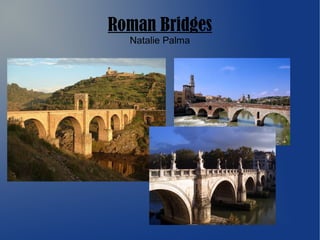
Roman bridges final assignment
- 2. Midieval Bridges After the fall of the Roman empire, between 476 AD to 1500 the building of Roman bridges slowed considerably. However, at that time bridges were known for the pointed arch instead of the smooth curve. With the pointed arches, the possibility for the crown of the bridge to sag was less likely, making it safer, and there was also less stress and a decreased chance for damage at the ends of the bridges. Brick and mortar (paste for assembling the bricks) was typically used for construction as the use for cement was lost.
- 3. Renaissance Bridges During this time after 1500 to 1700 the the prinicple of the truss which was typically used for roof support was taken on to use for bridge structures. Successul truss bridges were designed, however stone ones were still more popular. The midieval pointed arch design was also adapted but altered. The angle of the pointed curve was concealed and an elliptical arch was created. Therefore the span of the arch was much wider than the rise and the platform of the bridge was flat. The solution for problems caused by soft, wet soil was also discovered in 1591. Stone, concrete, or timber was used and placed in such a way around the base of the bridge that it was supported and did not slip or move. This technique is still used today.
- 4. th 18 Century Bridges By the middle of this century, around 1750 the bridge building in masonry reached its highest success. The use of cement was rediscovered and used once again for the building of bridges. Bridges with flat arches and slender pillars were designed and thought to be some of the most beautiful. Another method for sinking was also discovered during the time through 1739 to 1750. Large, watertight containers filled with stone were placed around each pier of the bridge, preventing sinking and enabling support. This method was a huge achievement.
- 5. Industrial Revolution Bridges During this time between 1779 through 1929 the use of timber and masonry for bridges was dismissed and replaced by iron or steel because it was stronger and less costly. The bridges built of this material were most commonly used for bridges over water, and they were proven to be more durable than those out of stone. The strength of the material, the way the structures were built, and the way the parts were organized easily allowed water to pass through it without causing damage.
- 6. th 19 Century Bridges As the hype of using less materials, being more cost efficient, and improving the weather withstanding ability continued, suspension bridges were designed and created, starting in around 1841. These bridges hang below suspension cables and have posts for support. Less materials are needed for these bridges which can reduce the cost, plus because of the floating like design it allows wind and water to easily move pass it without a large affect. During the 19th Century when using iron and steel frequently, the development of reinforced concrete was invented in 1867. To increase the strength and durability of the iron and steel in bridges the structure of these materials was coated in concrete, this led to tension and compression in the bridges.
- 7. American Civil War- World War I Bridges From 1861 through 1918 railroads had reached their peak during this time so bridges that could hold a heavier load including the load of a train were necessary. With new processes of making steel arising, the use of steel was significant for building bridges. A new method known as the cantilevering method was created for the construction of arches in around 1875. The arches were held up by cables and supported by temporary towers which were removed when the arches were self supportive.
- 8. th 20 Century Bridges By the 20th Century a couple more long, steel, suspension bridges were needed because there was an increase for accesibility to different places especially during the early 1900's from about 1903 to 1930. During this time specifically in 1930 the deflection theory was applied, this was especially used for the construction of long bridges. The cables and the deck of the bridge work together to carry loads. This occurs because the cables and the deck change directions together when struck by a load, as the length and weight increases the required stiffness for the deck decreases. The bridges would remain stable without having to make the structure bigger and stiffer because of the balance of flexibility and self-weight. Engineers liked this because they could then design bridges that looked lighter and more graceful without having to compromise safety.
- 9. st 21 Century Bridges As the years went on bridge construction only continued to improve, many of the same techniques and theories were still used, engineers just combined ideas and thought up new ways to incorporate different design processes with different materials. Most things that engineers know today and use in the construction of bridges are historical and used and invented in the past. All the past discoveries dating back to the Roman era are the base of the bridge construction, most of the procedures are still done today and over the years have just been tweaked or have had a change of perspective. Many bridges that still stand today were built hundreds of years ago, they display the intelligence of our ancestors, and stand as beauty, and to teach the engineers of our society bridge construction, what to learn from and what to improve on.
- 10. Bibliography Encyclopedia Britannica: Bridge http://www.britannica.com/EBchecked/topic/79272/bridge/72046/The-Middle-Ages Wikipedia the Free Encyclopedia: Roman Bridge http://en.wikipedia.org/wiki/Roman_bridge Wikipedia the Free Encyclopedia: Bridge http://en.wikipedia.org/wiki/Bridge